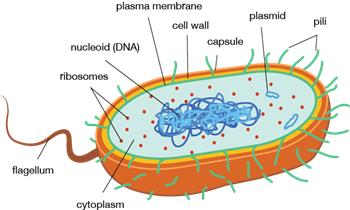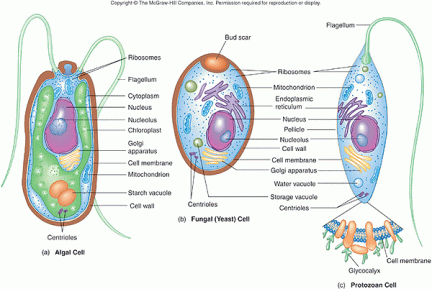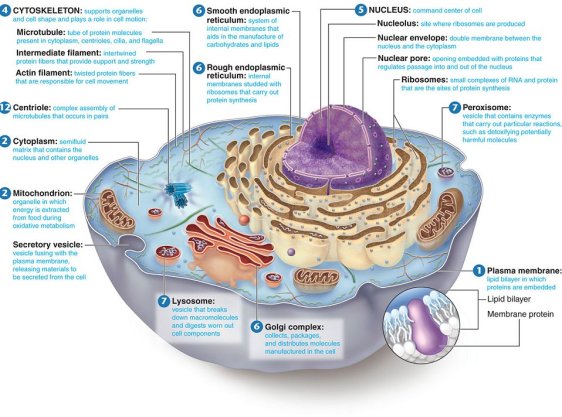The Basic Building Block of Life
The cell is the most important aspect of all living organisms although the fact, that it is the smallest component of the organism. Why is this? Because all reactions takes place in the cells. There are basically two different types of cells.
- Prokaryotes (no true nucleus)
- Eukaryotes (has a true nucleus)
Prokaryotes
These are single-celled organisms which contain no true nucleus and no membrane bound organelles in their cytoplasm. This means that their DNA (Deoxyribonucleic acid) is in a circular form and free not membrane bound. The only organelles they really have are ribosomes which have the function of protein-synthesis. Example of a prokaryote cells is the kingdom-Prokaryotae which mainly consists of bacterial cells.
Picture of a Prokaryotic Cell (Bacteria Cell)
Eukaryotes
These multi-cellular organisms have a true membrane bound nucleus as well as many different organelles. Their DNA is in a linear form found in the nucleus. Some key organelles found in this organism are; Nucleus, Cytoskeleton, Mitochondria, Lysosomes, Nucleolus etc. Examples of Eukaryotic Cells are classed in the Kingdoms; Protocitista, Fungi, Plantae and Animalia.
Picture of Eukaryotic Cells
The Main Differences between Prokaryotic Cells and Eukaryotic Cells
Prokayotes
|
Eukaryotes
|
| Very small in size usually about 0.5 Micrometers | Relatively large in size and can grow up to 40 Micrometers |
| Nuclear material is not surrounded by a membrane hence a circular form present in the cytoplasm | Nuclear material surrounded by a nuclear membrane and bounded tightly together with the help of Histones and they are present in the nucleus in the cytoplasm |
| No nucleus so no nucleolus present | Nucleolus present in the nucleus |
| Very few organelles present but they lack membranesFor example; Ribosomes | Any organelles present which are contained in membranes. There are Single Membrane Organelles such as; Golgi Apparatus, Endoplasmic Reticulum, Lysosomes , and there are Double Membrane Organelles such as; Nucleus, Mitochondria, Chloroplasts etc. |
| Cellular Reproduction via Binary Fission or Budding (mitosis) | Cellular Reproduction via Mitosis or Meiosis or both in some cases. |
| Some may contain rigid cell walls formed from glygoproteins (murein) | Fungi and Plant Cells contain polysaccharides that form Cell walls made out of chitin for Fungi and cellulose for plants. Animal Cells contains no cell walls |
| Contains 70 s (Svedberg) Ribomes | Contains 80 s Ribosomes |
Different Types of Eukaryotic Cells : Diagrams Showing Main Organelles And Their Functions
- The Plant Cell
Edible Plant cell make of Cake and gummies!! Now I wonder when will my students be making this for me? The choclit one looks nom O_o I wonder if Goldilocks crew can do..Let's try? Hm, better not..
http://burganfamily.blogspot.com/2010_10_01_archive.html
http://burganfamily.blogspot.com/2010_10_01_archive.html
- The Animal Cell
Credits to Biochem students Carlos, Shenelle, Liniker, Latisha, et. al
Similarities Between Plant Cell And Animal Cell
- They both contain a cell surface membrane which surrounds the cell.
- Both have cytoplasm in the cells.
- Both contains a Nucleus, Mitochondria, Endoplasmic Reticulum, 80 s Ribosomes etc.
Differences Between Plant Cells And Animal Cells
Plant Cells
|
Animal Cells
|
| Contains a Cell Wall composed of cellulose located to the outside of the cell’s surface membrane | Contains NO Cell Wall |
| Usually has a regular shape because of the presence of the Cell Wall | Usually has an irregular shape |
| Usually contains visible Chloroplasts containing the green pigment chlorophyll | No Chloroplasts present |
| Often has one very large Vacuole which contains cell sap | Has many small Vacuoles |
| Starch Granules present | Never are Starch Granules present, Glycogen Granules are seen |
SOME FACTS ABOUT CELLS
- THEY ARE MICROSCOPIC
Cells range in size from 1 to 100 micrometers and therefore cannot be seen with the naked eye only with a microscope. Advance microscopes such as the Scanning Electron Microscope and Transmission Electron Microscope, are able to obtain detailed images of the smallest of cell structures. - THERE ARE TWO MAIN TYPES
Eukaryotic and prokaryotic cells are the two main types of cells. Eukaryotic cells are called so because they have a true nucleus(Eu meaning true and karyote meaning nucleus). Animals, plants, fungi and protists are examples of organisms that are composed of eukaryotic cells. Prokaryotes include bacteria and archeabacteria. - PROKARYOTIC SINGLE CELLED ORGANISMS ARE THE MOST PRIMITIVE AS THEY WERE THE EARLIEST FORMS OF LIFE ON EARTH Prokaryotes can live in environments that would be deadly to most other organisms. They are able to live and thrive in various extreme habitats. Archaeans for example, live in areas such as hydrothermal vents, hot springs, swamps, wetlands, and even animal intestines.
- THERE IS A GREATER NUMBER OF BACTERIAL CELLS THAN ANIMAL CELLS IN THE HUMAN BODY
Scientists have estimated that about 95% of all the cells in the body are bacteria. The vast majority of these microbes can be found within the digestive tract. - CELLS HAVE GENETIC MATERIAL
Cells contain DNA (deoxyribonucleic acid), the genetic information necessary for directing cellular activities. DNA is a type of molecule known as a nucleic acid. In prokaryotic cells, the single bacterial DNA molecule is not separated from the rest of the cell but coiled up in a region of the cytoplasm called the nucleoid region. In eukaryotic cells, DNA molecules are located within the cell’s nucleus. DNA and proteins are the major components of chromosomes. Human cells contain 23 pairs of chromosomes (for a total of 46). There are 22 pairs of autosomes (non-sex chromosomes) and one pair of sex chromosomes. The X and Y sex chromosomes determine gender.











0 comments:
Post a Comment